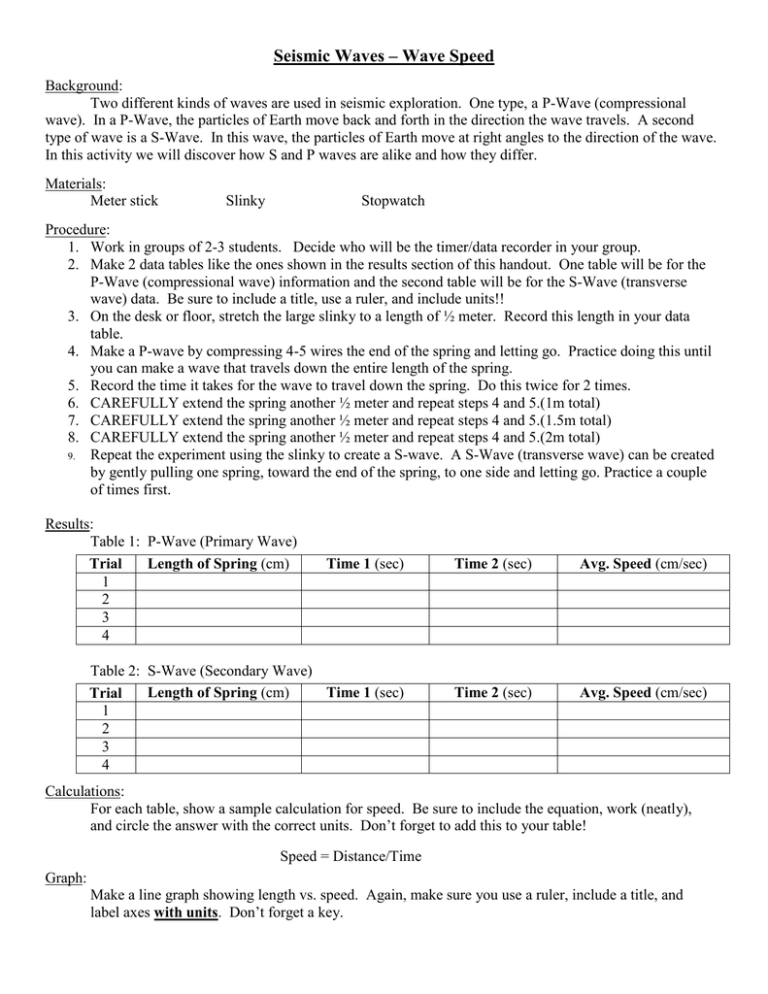Seismic Waves – Wave Speed
advertisement

Seismic Waves – Wave Speed Background: Two different kinds of waves are used in seismic exploration. One type, a P-Wave (compressional wave). In a P-Wave, the particles of Earth move back and forth in the direction the wave travels. A second type of wave is a S-Wave. In this wave, the particles of Earth move at right angles to the direction of the wave. In this activity we will discover how S and P waves are alike and how they differ. Materials: Meter stick Slinky Stopwatch Procedure: 1. Work in groups of 2-3 students. Decide who will be the timer/data recorder in your group. 2. Make 2 data tables like the ones shown in the results section of this handout. One table will be for the P-Wave (compressional wave) information and the second table will be for the S-Wave (transverse wave) data. Be sure to include a title, use a ruler, and include units!! 3. On the desk or floor, stretch the large slinky to a length of ½ meter. Record this length in your data table. 4. Make a P-wave by compressing 4-5 wires the end of the spring and letting go. Practice doing this until you can make a wave that travels down the entire length of the spring. 5. Record the time it takes for the wave to travel down the spring. Do this twice for 2 times. 6. CAREFULLY extend the spring another ½ meter and repeat steps 4 and 5.(1m total) 7. CAREFULLY extend the spring another ½ meter and repeat steps 4 and 5.(1.5m total) 8. CAREFULLY extend the spring another ½ meter and repeat steps 4 and 5.(2m total) 9. Repeat the experiment using the slinky to create a S-wave. A S-Wave (transverse wave) can be created by gently pulling one spring, toward the end of the spring, to one side and letting go. Practice a couple of times first. Results: Table 1: P-Wave (Primary Wave) Length of Spring (cm) Trial 1 2 3 4 Time 1 (sec) Table 2: S-Wave (Secondary Wave) Length of Spring (cm) Time 1 (sec) Trial 1 2 3 4 Time 2 (sec) Avg. Speed (cm/sec) Time 2 (sec) Avg. Speed (cm/sec) Calculations: For each table, show a sample calculation for speed. Be sure to include the equation, work (neatly), and circle the answer with the correct units. Don’t forget to add this to your table! Speed = Distance/Time Graph: Make a line graph showing length vs. speed. Again, make sure you use a ruler, include a title, and label axes with units. Don’t forget a key. Questions: 1. Diagram a S-Wave and a P-wave. Write the type of wave below your diagram. 2. Discuss the relationship between length and speed for each wave type. 3. Which wave type travels faster? 4. All waves lose energy as they travel. Wave types that lose less energy go farther. Which of the two types of waves used in the lab needed less energy to travel? 5. Which wave probably goes deeper into the Earth’s layers? Why? 6. Why is it important to understand seismic waves?





